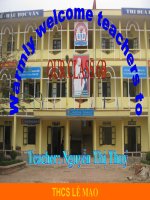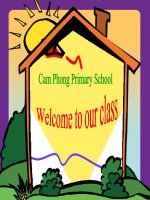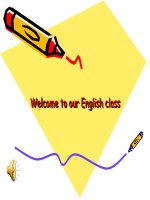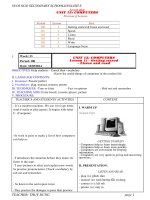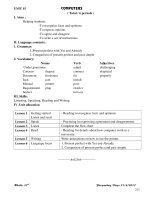unit 15 countries tiếng anh 6 sách cũ nguyễn thị hồng điều thư viện giáo án điện tử
Bạn đang xem bản rút gọn của tài liệu. Xem và tải ngay bản đầy đủ của tài liệu tại đây (793 KB, 14 trang )
<span class='text_page_counter'>(1)</span><div class='page_container' data-page=1>
Week:32 Planning date:11/4/2019
Period 96 Teaching date:
<b>UINT 15: COUNTRIES</b>
<b> Lesson 1: A. We are the world. (A1,2,3)</b>
<b>I. Aim</b>
By the end of the lesson, Ss will be able to talk about countries, nationalities, and
languages.
<b>II. Language contents</b>
<i><b> 1. Grammar</b></i>:
Structures: - Where is …….from?
He/She is from ……….
- I speak Vietnamese.
2. <i><b>Vocabulary</b></i>: (n) world, country, nationality, language, Japan, Japanese, China, Chinese,
Australia, Australian, Great Britain, British, Canada, Canadian, USA,
France, French
(v) speak
<b>III. Techniques</b>
Picture Drill, Rub out and remember
<b>IV. Teaching aids: pictures, tape</b>
<b>V. Procedures</b>
<b>Teacher’s and students ’ activities</b> <b>Content</b>
-T asks Ss some questions.
- Ss listen and answer.
- T corrects and gives marks.
- T presents the lesson.
- Ss listen
- T presents new words.
- Ss listen and write.
- Ss read (chorally, individually)
<b>1. Warm up: + marks</b>
<b>+Questions:</b>
- What’s today?
- Who’s absent today?
- What’s the weather like today?
- What weather do you like?
- What are you going to do this summer
vacation?
Etc…
<b>2. Presentation:</b>
Ex: I’m Mai, I am from Viet Nam and this is
John. He is from the USA.
</div>
<span class='text_page_counter'>(2)</span><div class='page_container' data-page=2>
- Ss play game.
- T presents the structure
- Ss listen and write.
- Ss read.
- T plays the tape.
- Ss listen and read.
(chorally, individually)
- Ss work in pairs
- T corrects.
- T plays the tape
- Ss listen and read.
- Great Britain (n)
- British
- Canada (n)
- Canadian (n)
- USA (n)
- France (n)
- French
Rub out and remember.
* Structure:
<i><b>- Where is she, he from?</b></i>
<i><b> are you</b></i>
<i><b> She, he is from ……….. </b></i>
<i><b> I am</b></i>
- I speak …../ She speaks …….
3. Practice:
<i><b> A</b>1 Listen and repeat</i>:
Picture drill.
Example exchanges:
S1: Where’s [Laura] from?
S2: She’s from [Canada]
Etc…….
</div>
<span class='text_page_counter'>(3)</span><div class='page_container' data-page=3>
- T plays the tape.
- Ss listen and repeat.
- T corrects
- Ss practice in pairs.
- T corrects.
( pair work)
(individually)
- T asks Ss to do exercises at home
<i><b>A3 Listen and read /P155</b></i>
<b>4. Production</b>
Ex1:
S1: Where are you from?
S2: I am from …….
Etc …….
Ex2:
- My name is …I am from…. I speak ……
5. Homework:
- Learn vocabulary, structure
- Do exercises A1-4
- Prepare A4-6
Comments
Week : 33 Planning Date:11/4/2019
Period: 97 Teaching Date:
<b>UINT 15: COUNTRIES</b>
<b> </b>
<b>Lesson 2: A. We are the world. (A4,5,6)</b>
<b>I. Aim: </b>
By the end of the lesson, Ss will be able to write a postcard about their vacation.
<b>II. Language contents:</b>
- <i><b>Grammar</b></i>: The simple present tense
- Where is she from? She is from Vietnam.
- What’s her nationality? She is Vietnamese.
- Which language does she speak? She speaks Vietnamese.
- <i><b>Vocabulary</b></i>: (n) postcard, Tower, place,
(a) interesting, wet
<b>III. Techniques: </b>
</div>
<span class='text_page_counter'>(4)</span><div class='page_container' data-page=4>
V. Procedures:
<b>Teacher’s and Ss’ activities</b> <b>Content</b>
- T asks Ss to play game.
- Ss play game.
- T corrects and gives marks.
- T presents the lesson.
- Ss listen
- T presents new words.
- Ss listen and write.
- Ss read (chorally, individually)
- T asks Ss some questions.
- Ss work in pairs.
- T corrects.
- T asks Ss to practice in pairs. Use the table on
exercise 3.
- Ss observe and practice.
- (pair work)
<b>1. Warm up: </b>
Picture drill:
Ex: S1: Where is he from?
S2: He is from Canada.
Etc……..
<b>2. Presentation:</b>
A4,5 / P156
<sub></sub> New words:
- postcard (n)
- Place (n)
- wet (a):
- interesting (a)
- Tower (n)
Rub out and remember.
* Comprehension questions:
(with answer key)
1. Who writes the post card? (<i><b>Nhan</b></i>)
2. Where is he? (<i>in London</i>)
3. What’s the weather like? (cool and wet)
4. Is he traveling by train? (<i><b>No, by bus</b></i>)
5. What is he going to do tomorrow?
(<i><b>visit the Tower of London</b></i>)
6. Who does Nhan write the postcard to?
(<i><b>Minh</b></i>)
7. Where is she? (<i><b>Hanoi</b></i>)
<b>3. Practice </b>
<b> A4. Make the dialogue</b>
S1: Who’s that?
S2: That’s...
S1: Where is she/he from?
S2: He/she is from...
</div>
<span class='text_page_counter'>(5)</span><div class='page_container' data-page=5>
- Ss read this postcard and write.
- T corrects
- Ss practice in pairs
- T corrects
- T asks Ss some questions
- Ss answer
- T corrects and gives marks
- T asks Ss to do the exercises at home
S1: Which language does he / she speak?
S2: He / She speaks ………
A<b>5: Write. </b>
Begin with:
Dear Nhan,
I am on vacation in . . . .
<b>A6: Answer. </b>
a. What’s your name?
b/ How old are you?
c/ Where are you from?
d/ Which language do you speak?
. . . ..
<b>4. Production + marks</b>
* <i>Questions. </i>:
a/ What’s your mother/ father name?
b/ How old is she/ he ?
c/ Where are you from?
d/ Which language do you speak?
…………..
<b>5. Homework: </b>
- Learn new words
- Do exercises A4-6
- Prepare B1,2,3,4
<i><b>Comments</b></i>
Week:33 Planing date : 18/4/2011
Period: 98 Teaching date:
<b>UNIT 15: COUNTRIES</b>
<b> </b>
<b>Lesson </b>
<b>3</b><b>: B. Cities , buildings and people. (B</b>
<b>1,2</b><b>)</b>
<b>I. Aim: By the end of the lesson, Ss will be able to compare places, using comparative and </b>
superlative of one syllable
</div>
<span class='text_page_counter'>(6)</span><div class='page_container' data-page=6>
<i><b> </b></i>Adjectives: Comparatives and superlatives
<i><b>2.Vocabulary</b></i>:
building (n), population (n), million (n) capital city (n)
<b>III. Techniques: </b>
- Rub out and remember
<b>IV. Teaching aids: pictures, tape</b>
<b>1. Procedures :</b>
<b>Teacher’s and Ss’ activities</b> <b>Content</b>
- T gives some words.
- Ss make the dialogues and practice in
pairs.
- T corrects and gives marks.
- T uses the pictures to present the lesson.
- Ss observe and listen.
- T presents new words.
- Ss listen and observe the pictures.
- Ss write.
- T reads
- Ss repeat. (chorally, individually)
- Ss play game.
- T presents Grammar.
- Ss listen and write.
- T explains Grammar.
- Ss listen .
<b>1. Warm up: + marks</b>
Ex: Lee, Yoko, ….
S1: Who’s that?
S2: That’s Lee.
S1: Where is he from?
S2: He is from China.
S1: What’s his nationality?
S2: He is Chinese.
S1: Which language does he speak?
S2: He speaks Chinese.
Etc…
<b>2. Presentation: </b>
* Pictures.
* New words.
- building (n)
- population (n)
- million (n)
- capital city (n)
* Rub out and remember.
* <i><b>Grammar</b></i>
<b>Adjectives: Comparatives and superlatives </b>
1. Comparatives:
a. Short adj:
Ex: A is bigger than B.
b. Long adj:
</div>
<span class='text_page_counter'>(7)</span><div class='page_container' data-page=7>
- T plays the tape.
- Ss listen and repeat.
- Ss read (chorally, individually)
- T corrects.
- T plays the tape.
- Ss listen and repeat.
- Ss read (chorally, individually)
- T corrects.
- Ss read the text and answer the questions.
- Ss work in pairs.
- T corrects.
Ex: Lan is more beautiful than Dao
2. Superlatives:
a. Short adj.
Ex: C is the biggest building.
<b>3. Practice: </b>
b. Long adj:
Ex: Lan is the most beautiful girl in this class.
<b>3. Practice:</b>
B1/ P 158
<b> B2 / P159 </b>
Key:
a. No, it isn’t.
b. Mexico City is the biggest city in the world.
c. Tokyo is bigger than London.
- How long/ high/ thick/ is the Great Wall?
It’s over 6,000 kilometers long.
S1 + be + more + adj + than + S2
S + be + the + adj + EST + N/pron
</div>
<span class='text_page_counter'>(8)</span><div class='page_container' data-page=8>
- Ss supply the correct form of adjectives in
bracket.
- T corrects and gives marks.
- T asks Ss to do exercises at home.
It’s between 4 and 12 meters high.
<b>4. Production + marks </b>
Use the correct adjectives in the bracket.
1. Summer is (hot) than spring
2. HCM City is the (big) city in VN
3. Lan is (tall) than Mai
4. Summer is the (hot) season in a year
5. Mexico city is the (big) City in the word
6. Hanoi capital is (small) than HCM city
7. the Mekong river (long) than red river
8. Tokyo is (small) than Mexico city
5. Homework:
- Learn vocabulary, Grammar
- Do exercises: part B in work book
- Prepare B3,4
*<i><b>Comments</b></i>:
Week: 33 Planning date:
Period: 100 Teaching date: 18/4/2011
<b>UNIT 15: COUNTRIES</b>
<b> </b>
<b>Lesson </b>
<b>4</b><b>: B. Cities, buildings and people. (B</b>
<b>3,4</b><b>)</b>
<b>I. Aim: By the end of the lesson, Ss will be able to understand the short dialogue and talk a lot of</b>
interesting places in the world.
<b>II. Language contents:</b>
<i><b>1.Grammar</b></i>:
<i><b> </b></i>- Which is taller Sears Tower or Petronas Twin Towers?
- How long (high/ thick) is the Great Wall? It’s ………….
<i><b>2.Vocabulary</b></i>:
Twin Towers(n), meter (n), high(a), long (a) The Great Wall (n), Structure (n), thick(a), 442
meters high, 6,000 kilometers long, 12 meters thick
<b>III. Techniques: </b>
- Rub out and remember, lucky numbers, questions and answers
<b>IV. Teaching aids: pictures, tape</b>
<b>V. Procedures:</b>
<b>Teacher’s and Ss’ activities</b> <b>Content</b>
- T asks Ss to play games
- Ss play games
<b>1. Warm up: + marks</b>
Lucky numbers
</div>
<span class='text_page_counter'>(9)</span><div class='page_container' data-page=9>
- T corrects and gives marks
- T uses the pictures to present the lesson.
- Ss observe and listen.
- T presents new words.
- Ss listen and observe the pictures.
- Ss write.
- T reads
- Ss repeat . (chorally, individually)
- Ss play game.
- T presents model sentences and explains
- Ss listen and write
- T plays the tape.
- Ss listen and read.
- Ss read (individually)
- T corrects.
5 6 7 8
9 10 11 12
1. smallest 3. bigger 4. million
6. The capital city 7. tall 9. building
10. house
*Các số may mắn: 2,5,8,10,12
Ex: 1. My city is the smallest city in the
country.
2. The dog is bigger than the cat
3. My city has a population of 1.0 million.
<b>2. Presentation: </b>
* Pictures.
* New words.
- meter (n)
- Twin Towers (n)
- The Great Wall (n)
- long (a)
- thick (a)
- high (a)
- 442 meters high:
- 6,000 kilometers long:
- 12 meters thick
* Rub out and remember.
Model sentences
<b>- Which is taller Sears Tower or Petronas Twin </b>
<b>Towers?</b>
<b>- How long (high/ thick) is the Great Wall? </b>
<b> It’s ………….</b>
<b>3. Practice:</b>
B3 / P160
Key:
</div>
<span class='text_page_counter'>(10)</span><div class='page_container' data-page=10>
- T plays the tape, Ss listen
- Ss read the text and answer the questions.
- Ss work in pairs.
- T corrects.
- Ss answer the questions
- T corrects and gives marks.
- T asks Ss to do exercises at home.
B4/ p161
- How long/ high/ thick/ is the Great Wall?
It’s over 6,000 kilometers long.
It’s between 4 and 12 meters high.
It’s over 9 meters thick.
<b>4. Production + marks </b>
Questions and answers
1. Which is the longest river in the world?
2. Which is the biggest city in Viet Nam?
3. Which is the highest mountain in Viet Nam?
5. Homework:
- Learn vocabulary, Grammar
- Do exercises: part B in work book
- Prepare C1,2
*<i><b>Comments</b></i>:
Week 34 Planning Date:18/4/2011
Period: 101 Teaching Date:
<b>UNIT 15: COUNTRIES</b>
<b>Lesson </b>
<b>5</b><b>: C. Natural features (C</b>
<b>1,2</b><b>)</b>
<b>I. Aim: </b>
_ By the end of the lesson, Ss will be able to use “<i><b>Lots of / a lot of / much</b></i>” as a quantifier with
geography vocabulary to describe Viet Nam
<b>II. Language contents:</b>
- <i><b>Grammar</b></i>: Simple present tense
<b> - Vocabulary: (n) forest, desert, rain, natural features, ( v) flow</b>
Lots of = a lot of
<b>III. Techniques:</b>
<b>- Picture drill, Slap the board, Rub out and remember, Matching. </b>
<b>IV. Teaching aids: pictures, tape </b>
</div>
<span class='text_page_counter'>(11)</span><div class='page_container' data-page=11>
<b>Teacher’s and Ss’ activities</b> <b>Content</b>
- T asks Ss some questions.
- Ss listen and answer.
- T asks Ss to give the correct form of the
adjectives in brackets
- Ss read and corrects.
-T calls 2 groups of Ss to go to the board
(each group- 2 students)
Ss listen carefully and slap the board.
- T presents the lesson and new words
- Ss listen and write
- Ss read new words (chorally, individually)
- Ss play game.
-T gives the model sentences and explains
- Ss write
<b>1. Warm up + marks</b>
- Good morning
- Who is absent today?
- <i><b>Give the correct form of the adjectives in </b></i>
<i><b>brackets</b></i>:
1. Lan is the (small) student in my class
2. Mexico city is the (big) city in the world
3. HCM city is (big) than Hanoi capital
4. What’s the (big) city in VN?
Key:
1. smallest, 2. biggest, 3. bigger 4. biggest
* <i><b>Slap the board</b></i>
<b>2.Pre - reading:</b>
Pictures
<i><b>New words</b></i>
- forest (n)
- desert ( n)
- rain (n)
- lots of = a lot of = much = many
- natural (a)
- feature (n)
- natural features
* Rub out and remember.
* <i><b>Model sentences</b></i>:
- We have lots of <i><b>mountains / rivers</b></i>
<i><b> Rain</b></i>
Beautifu green
beache lakes
</div>
<span class='text_page_counter'>(12)</span><div class='page_container' data-page=12>
- T plays the tape.
- Ss listen and read the text
- Ss read the passage and complete
- T corrects
(group work, pair work)
- Ss work in pairs.
- T corrects.
- T gives marks
- Ss play game.
- Ss and T correct.
- T asks Ss to do exercises at home.
- There are a lot of / lots of beaches in Viet
Nam.
<b>3. While - reading:</b>
<i><b> </b></i>
<i><b>C</b><b>1</b><b> Listen and read / P 162,163</b></i>
<i><b>* Picture drill. </b></i>
* <i><b> key</b></i>:
a. mountains b. rivers c. lake
d. rain e. forests f. beaches
<i><b>C</b><b>2</b><b> Look at the pictures again. Ask and </b></i>
<i><b>answer. </b></i>
S1: Does Viet Nam have any [<i>mountains]?</i>
S2: Yes, it does. / No, it doesn’t.
<b>4. Post - reading:</b>
Matching:
Laichau forests
Cantho beaches
Hanoi mountains
Pleiku rice fields
Danang rivers
Hue lakes
Quangninh rain
<b>5. Homework: </b>
- Learn new words, model sentences
- Do exercises C1,2 in work book.
- Prepare C3 / P 165
.<i><b>Comments</b></i>:
</div>
<span class='text_page_counter'>(13)</span><div class='page_container' data-page=13>
Week: 34 Planning date:22/4/2011
Period: 102 Teaching date:22/4/2011
<b>UNIT 15: COUNTRIES</b>
<b>Lesson </b>
<b>6</b><b>: C. Natural features (C</b>
<b>3</b><b>) </b>
<b>I. Aim: </b>
_ By the end of the lesson, Ss will be able to use adjectives: (comparatives and superlatives)
<b>II. Language contents:</b>
- <i><b>Grammar</b></i>: Review
<i><b> </b></i>comparatives and superlatives of adjectives<i><b> </b></i>
<b> - Vocabulary: (v) flow, sea (n). The Red River, The Mekong River, The Nile River, The </b>
Gulf of Tonkin, Tibet, The Mediterranean Sea, Mountain Everest
<b>III. Techniques:</b>
<b>- Picture drill, Rub out and remember</b>
<b>IV. Teaching aids: pictures, tape </b>
<b>V. Procedures:</b>
<b>Teacher’s and Ss’ activities</b> <b>Content</b>
- T asks Ss to play game.
- Ss play.
- T corrects.
- T presents the lesson and new words
- Ss listen and write
- Ss read (chorally, individually)
<b>1. Warm up + marks</b>
Picture drill.
S1: Does Viet Nam have any ………<i>?</i>
S2: Yes, it does. / No, it doesn’t.
<b>2.Pre - reading:</b>
C3 / P 165
<i><b>New words</b></i>
- flow (v)
- sea (n)
- The Red River (n)
- The Mekong River (n)
- The Nile River (n)
- The Gulf of Tonkin (n)
- Tibet (n)
</div>
<span class='text_page_counter'>(14)</span><div class='page_container' data-page=14>
- Ss play game.
- T plays the tape.
- Ss listen and read the text
- Ss read the questions and answer the
questions. (pair works)
- T corrects.
- Ss read the sentences and complete.
- T corrects.
- T asks Ss to do exercises at home.
- Mountain Everest (n)
* Rub out and remember.
<b>3. While – reading :</b>
<i><b> The text / P165 </b></i>
* Answer:
a. The Mekong river is the longest in
Vietnam
b. It starts in Tibet.
c. The Nile river is the longest in the world.
d. It flows to the Mediterranean Sea.
e. The highest mountain in the world is
Mount Everest
f. The highest mountain in Vietnam is
Phanxipang.
<b>4. Post - reading:</b>
* Complete the sentences.
a. The Mekong river is ___ than The Red
River. (long)
b. Her hair is ___ than his hair. (short)
c. It is the ___ building in this city. (big)
d. The Great Wall of China is the world’s
____ structure. (long)
<b>5. Homework: </b>
- Learn new words, model sentences
- Do exercises C3 in work book.
- Prepare Unit 16 A1,2, 3
Comments:
</div>
<!--links-->

